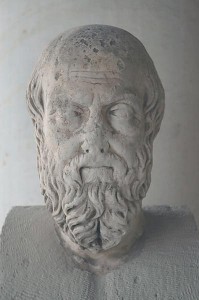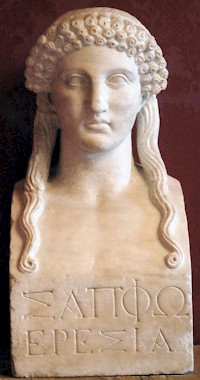Herodotus (5)
Herodotus of Halicarnassus (c.480-c.429 BCE): Greek researcher, often called the world's first historian. In The Histories, he describes the expansion of the Achaemenid Empire under its kings Cyrus the Great, Cambyses, and Darius I the Great, culminating in Xerxes' expedition to Greece (480 BCE), which met with disaster in the naval engagement at Salamis and the battles at Plataea and Mycale. Herodotus' book also contains ethnographic descriptions of the peoples that the Persians have conquered, fairy tales, gossip, and legends.
Herodotus' Sources

Herodotus claims to have visited the whole known world. Among his informers, he has priests from Greece, Egypt and Babylon; Africans, Arabs, Carthaginians, Cypriotes, Egyptians, Greeks, Italians, Palestinians, Persians, Phoenicians, Scythians... everyone seems to have been cooperative, and these interviews must have been Herodotus' most important source. Like a good journalist, Herodotus offers his audience different versions of the same event: not only does he offer a Greek account of the Persian raid on the Greek temple in Delphi (8.37) and the appearance of two supernatural helpers that reverted the Persian assault, but he has even been able to find a Persian informant of this divine intervention - thirty years after the event!
This is too good to be true, and there are more incidents where Herodotus' spokesmen are suspiciously well-informed. We are to believe that the Egyptians and Persians remembered the legendary war between the Greeks and Trojans. Babylonian priests give a description of the Esagila, the temple of their god Marduk that according to modern archaeologists does not fit the actual situation. As we have seen, Herodotus was not only known as the 'father of history' but also as the 'father of lies'.
It has been argued by the German classicist Detlev Fehling, that when Herodotus mentions his source, this is almost the best proof that he is not telling the exact truth. Unsatisfied with the real events, he decided to improve upon them, making it possible to show better the meaning of the events. There is a lot to be said for this suggestion; at least, it is almost certain that Herodotus did not go to Babylon. Some have argued that Fehling's criticism is a bit far-fetched. After all Herodotus had to write his tale many years after he had visited the place, and he never had the comfort of a map. This will no do: the Halicarnassian researcher wants us to believe that the walls of Babylon are 100 meters high - if he had indeed seen the town himself, he would not have written down such nonsense.
Sometimes, it is possible to check Herodotus' information. Comparison with cuneiform texts learns that almost every Persian name that he mentions, matches a real name. For example, Herodotus names the Persian leaders Cyrus, Cambyses, Hystaspes, Darius I the Great, Xerxes and Artaxerxes I Makrocheir; these are the Greek equivalents of Kurush, Kambujiya, Vishtaspa, Darayavaush, Khshayarsha and Artakhshaça. Courtiers receive plausible names as well, and this indicates that Herodotus was well-informed about the Persian court. (If he simply was making up things, the names would have been wrong. Other Greek authors' Persians have very un-Persian names.)
Herodotus must have had (indirect) access to at least two written Persian sources. In the first place, in Book Three, he is able to tell the story of Darius' coup d'état in considerable detail, and in line with the official Persian propaganda. We know the official story about the revolt of the Magians and Darius' accession to the throne from an inscription that was found in a town called Behistun (west of Hamadan in modern Iran). It tells essentially the same story; the only detail that Herodotus has wrong is the name of one of seven conspirators. Book Three also contains the second document, a list of provinces and revenues of the Achaemenid empire, which resembles comparable Persian documents (e.g., the Daiva inscription of Xerxes).
A third document - written in Greek - seems to be the source for the catalogue of Xerxes' army in Book Seven. In section 146 Herodotus tells us what kind of document this is. In the winter of 481/480, three Greek spies were sent to Sardes, where the Persian army was gathering.

As has already been pointed out, Herodotus was a rich man, and well-educated. He knew the literature of his age: he quotes not only Homer, but also Hesiod, Sappho, Pindar, and Aeschylus. The latter was a playwright, and indeed, its seems that Herodotus sometimes used tragedies as sources.
Herodotus had als read the Description of the earth by Hecataeus of Miletus (550-490), and sometimes ridicules this Greek geographer. However, we know that in his second book, Herodotus sometimes plagiarized his predecessor.note Another geographer he used, was Scylax of Caryanda, who had visited India and coasted the shores of the Indian Ocean and Persian Gulf.
ast but not least, he knows many stories that were told among Greek noble families, among which is one of the two Spartan royal dynasties. We can imagine how he was invited to deliver a lecture, stayed with an aristocratic family, and how he heard the stories about the astonishing achievements of the family, of which he preserved the memory by putting them on record.
So, Herodotus combined the results of interviews and family stories, had read the books that were available and knew at least three relevant documents. We may add that he (pretends to have) traveled extensively, so that he can often claim autopsy of a location. The following remark is a good summary of Herodotus' method.
So far the Egyptians themselves have been my authority; but in what follows I shall relate what other people, too, are willing to accept in the history of this country, with a few points added from my own observation.note